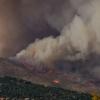
Wildfires are a growing threat to the boreal north, especially under the rapidly changing climate. IIASA researchers modeled and analyzed how climate change may impact future burned area in boreal forests and highlighted the importance of mitigation and adaptation strategies to reduce climate-fueled impacts on wildfires.
Boreal forests often bring to mind snowy tundra, vast bogs, and diverse fauna such as reindeer or moose. However, it is increasingly home to a large number of wildfire occurrences. From the large fires in Sweden in 2014 and 2018, to the devastating fires in Siberia in 2021 and Canada in 2023, boreal forests are facing unprecedented levels of disturbance from wildfire events. These serve as a harbinger of what is to come in the upcoming decades, not just to the arctic north, but to forests around the globe.
In their study published in the journal Fire, lead author Shelby Corning and her colleagues, all researchers in IIASA’s Biodiversity and Natural Resources Program, utilized their data-driven, algorithm-based wildfire climate impacts and adaptation model (FLAM) to project and analyze climate impacts on burned area estimates in the boreal zone. The study explored future fire events under four climate change scenarios and two adaptation scenarios to better understand the role of temperature, precipitation, and suppression efficiency on burned area in the boreal ecosystem.
Corning and her colleagues found that their model performed well in reproducing historic burned areas with high accuracy when considering multiple climatic conditions, highlighting the importance of considering various scenarios when making projections for the future. “Our study emphasizes the outstanding impact of climate change on boreal wildfires,” explains Corning. “Forested burned area is predicted to increase by up to four times present-day burned area by the end of the century,” she says. Her colleague and FLAM team leader Andrey Krasovskiy states that “we need to urgently take preventative measures by combatting climate change. The best-case climate scenario (RCP 2.6) will result in only minimal increases in burned area by 2100. Furthermore, we need to quickly ramp up adaptation strategies, such as by improving fire suppression to within 4 days, which would lead to a nearly 50% reduction in burned area, even under the worst-case climate scenario.” Overall, the results were eye-opening: without intervention, boreal forests and the communities who rely upon them are at great risk from climate change-fueled fires.
This study from the FLAM team was initially presented at the 20th International Boreal Forest Research Association (IBFRA) Conference held in 2023 in Helsinki, Finland, where it benefitted from boreal experts’ feedback. It is an important step to better understand boreal wildfires and how we might manage climate change impacts on wildfires in the biodiverse taiga. Further, it showcases the capabilities of FLAM to reproduce and predict wildfires and burned area – leaving room for exploration of other ecosystems and global fires.
Corning, S. , Krasovskiy, A. , Kiparisov, P. , San Pedro, J. , Viana, C.M., & Kraxner, F. (2024). Anticipating Future Risks of Climate-Driven Wildfires in Boreal Forests. Fire 7 (4) e144. 10.3390/fire7040144.
News

06 March 2025
Crafting narratives for a resilient and coherent Trans-European Nature Network

18 December 2024
Celebrating a year of impact: IIASA highlights in 2024

12 December 2024


